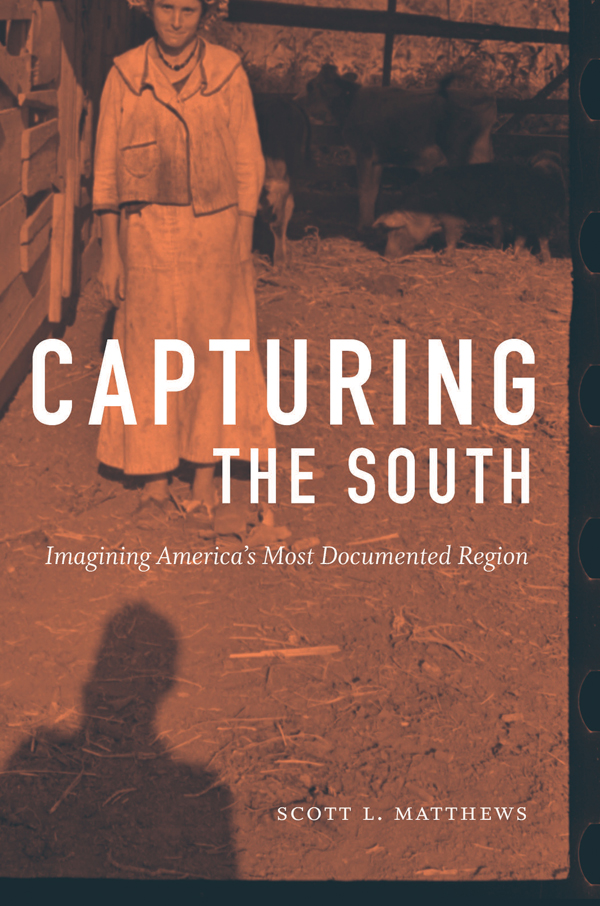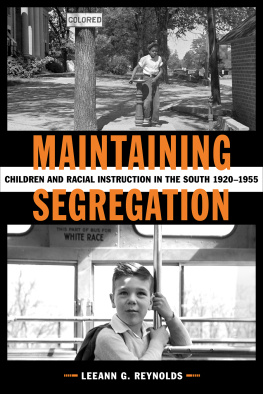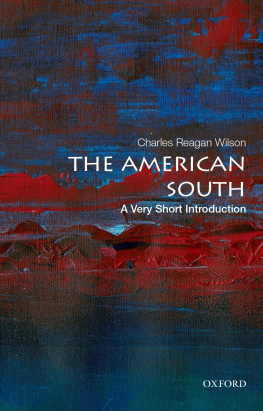Contents
Guide
Pagebreaks of the print version

Capturing the South
Capturing the South
Imagining Americas Most Documented Region
Scott L. Matthews
Published by the University of North Carolina Press, Chapel Hill, in association with the Center for Documentary Studies at Duke University
This book was sponsored by the postdoctoral fellows program at the Center for the Study of the American South, University of North Carolina at Chapel Hill.
2018 The University of North Carolina Press
All rights reserved
Set in Merope Basic by Westchester Publishing Services
Manufactured in the United States of America
The University of North Carolina Press has been a member of the Green Press Initiative since 2003.
Library of Congress Cataloging-in-Publication Data
Names: Matthews, Scott L., author.
Title: Capturing the South : imagining Americas most documented region / Scott L. Matthews.
Description: [Chapel Hill, North Carolina] : Published by the University of North Carolina Press, Chapel Hill, in association with the Center for Documentary Studies at Duke University, [2018] | Includes bibliographical references and index.
Identifiers: LCCN 2018017918 | ISBN 9781469646442 (cloth : alk. paper) | ISBN 9781469646459 (pbk : alk. paper) | ISBN 9781469646466 (ebook)
Subjects: LCSH : Social sciencesResearchSouthern StatesHistory20th century. | Social scientistsSouthern StatesHistory20th century.
Classification: LCC H 62.5. U 5 M 383 2018 | DDC 975/.043dc23 LC record available at https://lccn.loc.gov/2018017918
Cover illustration: Photograph of Dora Mae Tengle, 1936, by Walker Evans. LC - USF 3301-031301- M 4, FSA / OWI Collection, Prints and Photographs Division, Library of Congress.
This book includes previously published material, used here with permission. An earlier version of chapter three appeared as John Cohen in Eastern Kentucky: Documentary Expression and the Image of Roscoe Halcomb during the Folk Revival, Southern Spaces (August 2008), doi:10.18737/M74W3W. An earlier version of chapter five appeared as Protesting the Privilege of Perception: Resistance to Documentary Work in Hale County, Alabama, 19002010, Southern Cultures 22, no. 1 (Spring 2016): 3165.
DOCUMENTARY ARTS AND CULTURE
Edited by Alexa Dilworth, Wesley Hogan, and Tom Rankin of the Center for Documentary Studies at Duke University
In a time when the tools of the documentary arts have become widely accessible, this series of books, published in association with the Center for Documentary Studies at Duke University, explores and develops the practice of documentary expression. Drawing on the perspectives of artists and writers, this series offers new and important ways to think about learning and doing documentary work while also examining the traditions and practice of documentary art through time.
Center for Documentary Studies at Duke University https://documentarystudies.duke.edu
Contents
Illustrations
Acknowledgments
This book exists because I was fortunate enough to cross paths with people who took the time to recognize my passions and push me along when I doubted my way. At the University of Virginia (UVA), Ed Ayers listened one day as I wondered whether I belonged in the graduate program in history. He reassured me and affirmed my research interests by giving me a book from his shelf, After Freedom: A Cultural Study in the Deep South , written in the 1930s by anthropologist Hortense Powdermaker, and by recommending another, Tenants of the Almighty , by sociologist Arthur Raper with photographs by Farm Security Administration photographer Jack Delano. Eds support and generosity lit the first path that led me to write Capturing the South .
While at UVA, I had the great fortune of having Grace Hale as an advisor. She championed my writing and teaching at every turn while also consistently pushing me to become better at both. I had the honor of serving as a teaching assistant for her courses on the twentieth-century South and poverty in America: Grace encouraged me to develop classes that revolved around our shared interests in documentary work; ill advisedly allowed me to give rambling lectures on John Lomaxs field recordings from Sumter County, Alabama; and, most importantly, provided me with a model of innovative and inspiring teaching. Graces books and essays are also touchstones of cultural history. Her influence is evident throughout this book.
I was also fortunate to work as a teaching assistant with the late Julian Bond for a number of semesters. He encouraged me to carve out class time to teach my own interests, including civil rights movement photography. One of the first times I met him I told him about my love of the photographs Danny Lyon made for the Student Nonviolent Coordinating Committee in the 1960s. He then spent an hour with me turning the pages of one of my favorite books, Lyons Memories of the Southern Civil Rights Movement , and telling me the backstories of many of the photographs, which he knew well because of his role as SNCCs communications director. Over the years, he also regularly passed along books and films he thought I would like, including rare documentary films made for SNCC during the 1960s. I wish I could hand him a copy of this book.
I am extraordinarily grateful for the financial and institutional support I received while writing Capturing the South , including fellowships at the Smithsonian Institutions Museum of American History and at the University of North CarolinaChapel Hills Center for the Study of the American South (CSAS). At the Smithsonian, I had the pleasure of working with historian Pete Daniel and curator of photography David Haberstich. The year I spent as a fellow at CSAS almost seems like a dream now. I can never adequately thank Bill Ferris for his encouragement and support of my book project and his willingness to allow me to sit in on two of his classes on southern literature and music. I am also grateful to Tom Rankin for allowing me to sit in on his class Documenting the Sacred South. There were many others who worked at CSAS who became great colleagues during my time in Chapel Hill, including Ayse Erginer and Emily Wallace, the superb editors of the journal Southern Cultures ; the CSAS director Harry Watson; and my fellow fellow that year, Tammy Ingram. I also received a generous research fellowship from the Frances S. Summersell Center for the Study of the American South at the University of Alabama. I am particularly grateful to the librarians and archivists at the Wilson Library, Southern Historical Collection, and Southern Folklife Collection at UNC, as well as at the W. S. Hoole Special Collections Library at the University of Alabama, for diligently fulfilling my requests.
The fellowship at CSAS brought with it an opportunity to publish my book with the University of North Carolina Press and its Documentary Arts and Culture series in association with the Center for Documentary Studies (CDS) at Duke University. In college I had developed an abiding interest in the evocative sociological and ethnographic studies published by UNC Press during the 1920s and 1930s. It seems incredible to me that I am now publishing a book about some of those studies with that fabled press. I am eternally grateful to the people at UNC Press who have helped make this possible. David Perry and Joe Parsons were early editors who guided me through the manuscripts first stages. Since then, I have had the pleasure of working with Lucas Church, who has helped make this book immeasurably better. Mark Simpson-Vos, editorial director at the press, and Tom Rankin, editor of the Documentary Arts and Culture series and documentary studies professor at CDS, have also supported and championed this book at every stage. They have been exceedingly patient over the years as parenthood and large teaching loads slowed the revision process to a crawl.




